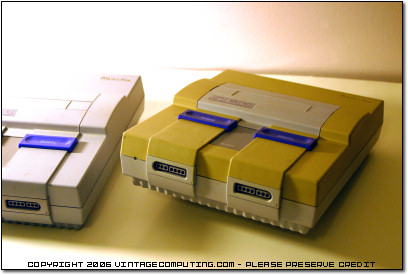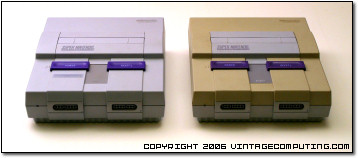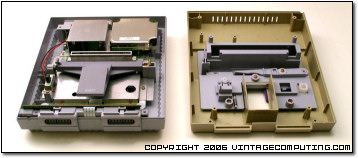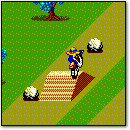 I have a box of about eight musty, “doorstop quality” Commodore 64’s (C64) and VIC-20’s sitting up in my attic. They came from a local hamfest a few years ago. It was getting late in the show that day and the vendors were tired and wanted to go home. At the end of any hamfest, vendors have tons of near-worthless, unsold, bulky junk that they’d usually rather throw away than drag back to their car. I have been stuck in a situation at least four or five times where I was interested in buying one item, but would only be allowed to purchase the item if I agreed to haul off all kinds of other crap for the seller. In this case, I just wanted to buy a single box of C64 disks that I noticed sitting on a table, but the guy would only sell it to me if I agreed to take six C64s, five Vic-20s, a few disk drives, lots more accessories and carts, and…well, there wasn’t just one box of disks, after all, but more like ten. It was like some Vaudeville routine: as soon as I thought the seller had pulled the last box of Commodore-spew from under the table and turned to leave, he’d say “oh wait!” and pull out another one. At this point my father, who was saddled with the unenviable task of helping me carry all these musty artifacts to our car, had a severe grimace on his face. That day I inherited some guy’s entire Commodore collection for $10, including his massive anthology of pirated C64 game disks (complete with a thick three-ring-bound index to the disks!), and I think my dad inherited some permanent “Commodore grimace” lines in his forehead.
I have a box of about eight musty, “doorstop quality” Commodore 64’s (C64) and VIC-20’s sitting up in my attic. They came from a local hamfest a few years ago. It was getting late in the show that day and the vendors were tired and wanted to go home. At the end of any hamfest, vendors have tons of near-worthless, unsold, bulky junk that they’d usually rather throw away than drag back to their car. I have been stuck in a situation at least four or five times where I was interested in buying one item, but would only be allowed to purchase the item if I agreed to haul off all kinds of other crap for the seller. In this case, I just wanted to buy a single box of C64 disks that I noticed sitting on a table, but the guy would only sell it to me if I agreed to take six C64s, five Vic-20s, a few disk drives, lots more accessories and carts, and…well, there wasn’t just one box of disks, after all, but more like ten. It was like some Vaudeville routine: as soon as I thought the seller had pulled the last box of Commodore-spew from under the table and turned to leave, he’d say “oh wait!” and pull out another one. At this point my father, who was saddled with the unenviable task of helping me carry all these musty artifacts to our car, had a severe grimace on his face. That day I inherited some guy’s entire Commodore collection for $10, including his massive anthology of pirated C64 game disks (complete with a thick three-ring-bound index to the disks!), and I think my dad inherited some permanent “Commodore grimace” lines in his forehead.
 I climbed up into my fiberglass dust-ridden attic the other day, looking for an ideal donor of a 6510 processor to add to my CPU collection. Temptingly, in my Commodore box there was a C64 already apart and in pretty bad shape — an ideal sacrificial Commie to dissect. Upon bringing it down and looking inside the case, I found something pretty amusing: some guy — presumably the previous owner — was fiddling with the power connector in the unit and somehow broke the ground contact and corresponding pin off the connector. It looks to me like he was in the middle of laboring to remove the connector when he was abruptly struck with Sudden Onset Lack-Of-Patience Disorder (or SOLOPD, a common affliction amongst electronics tinkerers). Soon after, his strategy for connector removal became “rip it off any way you can.” Unsurprisingly, he broke his machine in the process. Through the magic of literary time travel, we can infer what obviously happened afterwards as he attempted a repair:
I climbed up into my fiberglass dust-ridden attic the other day, looking for an ideal donor of a 6510 processor to add to my CPU collection. Temptingly, in my Commodore box there was a C64 already apart and in pretty bad shape — an ideal sacrificial Commie to dissect. Upon bringing it down and looking inside the case, I found something pretty amusing: some guy — presumably the previous owner — was fiddling with the power connector in the unit and somehow broke the ground contact and corresponding pin off the connector. It looks to me like he was in the middle of laboring to remove the connector when he was abruptly struck with Sudden Onset Lack-Of-Patience Disorder (or SOLOPD, a common affliction amongst electronics tinkerers). Soon after, his strategy for connector removal became “rip it off any way you can.” Unsurprisingly, he broke his machine in the process. Through the magic of literary time travel, we can infer what obviously happened afterwards as he attempted a repair:
There he was, cradling the lifeless body of a broken C64 in his arms, crying and cursing himself for his impatience and uneven temperament. He broke down on his knees and swore to the heavens to never harm another 64 again if only the Commodore Gods would ease his suffering and forgive him for his mistake. But alas — his cries of desperation fell only on deaf ears (the 22 year-old family cat). And like any man whose most desperate call goes unheard, something turned inside him. For a brief moment, all that was dark and cruel welled up within him, twisting his soul in queer ways as a streak of fiery evil flashed over his hollow eyes. He raised his arms, clutching the helpless computer over his head, and nearly bashed the faulty unit into the darkest form of oblivion. But at the last moment, something stopped him: a key from the unit fell to the floor beneath him. It was the “plus” key — the very first key he pressed on the greatest day of his life. Vivid images of his 15th birthday flooded his head, filling him with a deep sense of regret over what he almost did. It was on that day that he received the very machine he was clutching from his late grandfather. How could he forsake old Roy — always happy, smiling, and helpful — and the desire for a better life that he handed down to his only grandson in the form of a $300 personal computer? It was then that the man decided that he should spare the machine; he would fix it. But how would he achieve such an impossible task? He didn’t have any spare C64 power connectors, and, after all, replacing the connector required removing the old one — the very problem that got him into this mess to begin with! Frantically searching for a solution, he scratched through his junk box until his fingers nearly bled. In the dustiest, farthest back corner of his tattered box, he found it: a nail. Yes! He thought back to his summer job as a carpenter with his grandfather’s construction business — lesson number one in his carpentry training taught him that a common picture frame-hanging wall nail, when used properly, was the perfect solution to any troubling situation. He quickly put his MacGyver-like improvisation skills to work, firing up his soldering iron to melt the broken connector’s mangled plastic and fuse the nail in place. After an intense four-hour operation with many close-calls and stressful moments, he was finished. He plugged the proper power supply into the machine and, with great tension, flipped it on. Tears of joy streamed from his reddened, tired eyes as he saw the bright, vibrant power LED light up. “If only Papa Roy were here to see this,” he thought, as he ran his hand across the smooth back of his favorite machine. “May this heavy light that shines upon me forever serve as a beacon, steering and guiding me through the foggiest, darkest, and stormiest nights of my life.” The ordeal was finally over, and he knew he would never be the same man again.
Yes, he used a nail to act as a ground contact, bridging the outer ground ring of the C64’s DIN power connector and the RF shielding of the cartridge port. Does it really work? I don’t know; I don’t care to try. Personal revelations for the man aside, this has to be the messiest improvised hack I’ve ever seen in my life. At least we got a good story out of it.

Hacks like these should make us all stop and think more deeply about ourselves.

 My first SNES console (right) exhibits discoloration on the top half only.
My first SNES console (right) exhibits discoloration on the top half only. The top half and bottom half of my first SNES console, disassembled.
The top half and bottom half of my first SNES console, disassembled.
 [Editor’s Note: Apologies for not getting this up sooner. Johnny had it ready a few weeks ago, but as you all probably know, I was busy moving. Anyway, here it is.]
[Editor’s Note: Apologies for not getting this up sooner. Johnny had it ready a few weeks ago, but as you all probably know, I was busy moving. Anyway, here it is.]




 On Monday I did a hack of a NES that I will be posting an article about soon, but I’m already hungry for my next project. I’ve caught the hacking bug, I tell ya — since I finished my last project I’ve been compulsively and obsessively looking at every object in my house in a new way, asking myself “How can I chop that device into pieces and turn it into something more interesting?” Lurking in the bottom of a closet I found an ideal candidate for a hack: an old
On Monday I did a hack of a NES that I will be posting an article about soon, but I’m already hungry for my next project. I’ve caught the hacking bug, I tell ya — since I finished my last project I’ve been compulsively and obsessively looking at every object in my house in a new way, asking myself “How can I chop that device into pieces and turn it into something more interesting?” Lurking in the bottom of a closet I found an ideal candidate for a hack: an old  A lot of people are making their own digital picture frames out of old laptops these days (mounting a laptop screen in a picture frame with the computer behind it to hang on the wall and display a random picture slide show), but my 190 only has a 4-bit greyscale passive matrix display, so pictures won’t look too impressive on it. It would be cool to make a semi-permanent, wall-mountable installation out of it, but what would it display? Well, if I could get a reliable network connection to it, it could be a window on all kinds of things on the net, displaying activity from my MUSH, weather info, VC&G traffic statistics, news, or any number of things, as long as there is an application that runs in Mac OS System 7.5.2 to display it. My fiance suggested a permanent digital ant farm, which is a great idea, but I still haven’t found a program or screen saver for the classic Mac OS that simulates one in an aesthetically pleasing way. A friend of mine suggested that I put some form of Linux on it and then I could do all sorts of network-related things that are not as easily achieved in Mac OS 7. But putting Linux on a Mac this old and getting it to work — especially with some ethernet adapter — is a challenging project unto itself. So I’ve been tinkering and I’ve got some new ideas, but I’ll wait until I’m done to share them with you (I’ll give you a hint — well, kinda — just look at the picture above). Until then, I ask you: what should I hack my PowerBook 190 into? Ideas? Suggestions? Leave me a comment and we’ll talk!
A lot of people are making their own digital picture frames out of old laptops these days (mounting a laptop screen in a picture frame with the computer behind it to hang on the wall and display a random picture slide show), but my 190 only has a 4-bit greyscale passive matrix display, so pictures won’t look too impressive on it. It would be cool to make a semi-permanent, wall-mountable installation out of it, but what would it display? Well, if I could get a reliable network connection to it, it could be a window on all kinds of things on the net, displaying activity from my MUSH, weather info, VC&G traffic statistics, news, or any number of things, as long as there is an application that runs in Mac OS System 7.5.2 to display it. My fiance suggested a permanent digital ant farm, which is a great idea, but I still haven’t found a program or screen saver for the classic Mac OS that simulates one in an aesthetically pleasing way. A friend of mine suggested that I put some form of Linux on it and then I could do all sorts of network-related things that are not as easily achieved in Mac OS 7. But putting Linux on a Mac this old and getting it to work — especially with some ethernet adapter — is a challenging project unto itself. So I’ve been tinkering and I’ve got some new ideas, but I’ll wait until I’m done to share them with you (I’ll give you a hint — well, kinda — just look at the picture above). Until then, I ask you: what should I hack my PowerBook 190 into? Ideas? Suggestions? Leave me a comment and we’ll talk! [Editor’s Note: This article was written by Johnny as his first contribution to VC&G.]
[Editor’s Note: This article was written by Johnny as his first contribution to VC&G.] Here’s a quick gaming tip that especially applies to those of you with shoddy power companies. For years, it seemed my house would have power flashes at least a couple times a month. There was something about the power on my block that was especially unreliable (nearby transformers seemed to blow all the time), and it got really annoying. Naturally, I got
Here’s a quick gaming tip that especially applies to those of you with shoddy power companies. For years, it seemed my house would have power flashes at least a couple times a month. There was something about the power on my block that was especially unreliable (nearby transformers seemed to blow all the time), and it got really annoying. Naturally, I got  Ah…more on my continuing adventures with the not-so-vintage, but very much obsolete
Ah…more on my continuing adventures with the not-so-vintage, but very much obsolete 



